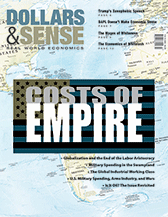
The Economics of Whitelash
Race, Gender, Income, and Education in the Presidential Election
This article is from Dollars & Sense: Real World Economics, available at http://www.dollarsandsense.org

This article is from the
March/April 2017 issue.
Subscribe Now
at a 30% discount.
“White Voters Delivered a Payoff: One factor among a multitude that led to Republican Donald Trump’s surprise win,” by Laura Meckler, Wall Street Journal, Nov. 9, 2016
“Donald Trump’s Victory Was Built on Unique Coalition of White Voters,” by Nicholas Confessore and Nate Cohen, New York Times, Nov. 9, 2016.
“‘Forgotten’ white vote powers Trump to victory: Campaign unleashed previously unseen level of vitriol in US politics,” by Shawn Donna, Financial Times, Nov. 9, 2016.
Donald Trump’s election victory was “a whitelash against a changing country,” Van Jones, black activist and former Obama administration green jobs czar, told a CNN election-night audience.
His analysis was hardly unusual. The headlines of leading newspapers made much the same point the next morning. They attributed Trump’s victory in large part to “white voters,” “a coalition of unique white voters,” or a “forgotten white vote.”
But the story of the presidential election is far more complex than these headlines suggest. To begin with, the popular vote went to Clinton, not Trump. Nor should the election results be read as a rebellion of the economic dispossessed, for Trump supporters were on average better off, not worse off, than those who opposed him. Perhaps the most significant factor characterizing those who voted for Trump was that they were people who saw their relative positions in society declining or under threat of declining.
What best explains the “whitelash” of November 8 is the changing economic fortunes of white men without a college degree relative to women and to minorities, and eroding race and gender privilege.
Who Voted for Whom?
Most every television network and major newspaper provided an instant analysis of the presidential election based on exit-poll data collected by Edison Research. From those data come the voting patterns we are all undoubtedly familiar with by now: whites, men, and those without a college degree voted for Trump by large margins; white men and whites without a college degree, by even larger margins.
But it’s not possible to use exit-poll data to tease out who voted for Trump in a way that gets at the intersection of race and income. For instance, a majority of lower-income voters (with incomes less than $50,000) favored Clinton, not Trump. Edison Research doesn’t separate these numbers by race. Surely minorities, the majority of whom live in households with incomes less than $50,000, cast many of those Clinton votes. Nonetheless, this seems to fly in the face of attempts to attribute Trump’s victory to support from the economically insecure.
What’s more, Trump’s percentage of the white vote was no higher than Romney’s had been in 2012. Admittedly, Trump did much better among low-income voters and whites without a college degree than Romney had. Washington Post Wonkblog author Jeff Guo estimated that for the counties of nine “rustbelt” states (Illinois, Indiana, Iowa, Kentucky, Michigan, Ohio, Pennsylvania, West Virginia, and Wisconsin) each 10% increase in the population of non- college educated whites correlated to a 3-percentage-point increase in Trump’s winning margin. Finally, while Clinton carried union households, Trump ate into the Democrats’ advantage among them, reducing it from 18 percentage points in 2012 to eight percentage points in this election.
A Profile of Trump’s Supporters
A Gallup telephone survey of 125,000 adults conducted from July 8, 2015, through October 11, 2016, tells us much more about who supported Donald Trump than what can be garnered from exit-poll data. Using data from that survey, Gallup economists Jonathan Rothwell and Pablo Diego-Rosell isolate the factors that would lead someone to view Trump favorably. Rothwell and Diego-Rosell found “mixed evidence” that economic distress had motivated Trump’s support, and concluded, “Trump’s popularity cannot be neatly linked to economic hardship.”
To begin with, by standard economic measures Trump supporters are doing better than those who opposed him. The average (or mean) household income of Trump supporters was $81,898—about $2,600 above the national average—compared with $77,046 for those who didn’t support him—about $2,200 below the national average. Trump supporters were less likely to be unemployed and less likely to be employed part-time than those who opposed Trump. In addition, Trump’s support was higher than Clinton’s among skilled blue-collar workers (in jobs such as construction, installation, maintenance and repair, and transportation) that tend to pay better than service jobs. Business owners and managers were more likely to favor Trump than Clinton. Finally, and surprisingly, Rothwell and Diego-Rosell found no evidence that Trump supporters were more exposed to competition from immigrants and foreign workers than those who opposed Trump.
Nonetheless, Trump’s supporters face important disadvantages. Just over one-quarter of Trump’s supporters had a bachelor’s degree, while just over one-third of those who didn’t favor Trump held a bachelor’s degree. And more professionals favored Clinton than favored Trump.
On top of that, Trump supporters had worse health outcomes (measured by higher mortality rates and greater disability rates) and lower social mobility (measured by income rank at age 30 of individuals raised at the 25th percentile of the national distribution of income) than Clinton supporters did in their study.
Trump’s support came disproportionately from counties with low population and fewer college graduates. His supporters live in zipcodes that are disproportionately white, and in neighborhoods (census tracts) with lower levels of racial and ethnic diversity than the neighborhoods of Clinton supporters. Rothwell and Diego-Rosell worry that Trump supporters’ limited interactions with blacks, Asians, Hispanics, and college graduates “may contribute to prejudicial stereotypes, political and cultural misunderstandings, and a general fear of not belonging.”
Labor Market Rents and Changing Economic Fortunes
An economist I know posted a Facebook comment about the Gallup findings immediately after the election, saying he was struck by the incongruity that Trump supporters had fewer educational credentials and were less likely to be in professional occupations but still commanded higher incomes. For this economist, the source of Trump supporters’ labor market “rents”—their ability to earn more than what their skill set would predict—was most likely race and gender privilege. As he sees it, social capital rooted in race and gender privilege is what the typical Trump supporter—a relatively privileged male high-school graduate—stands to lose from the disruption of the social order.
This analysis is correct as far as it goes. But the typical Trump supporter has already seen much of their labor market rents evaporate with the changing fortunes of white men, women, and minorities. It is not just the prospect of losing privilege but the privileges already lost that fueled the “whitelash.”
In his recent paper, Urban Institute economist Stephen Rose throws those losses into sharp relief. Rose compares the economic position of white men without a college degree in 1960 with where they stand in today’s economy.
The 1960s U.S. economy differed from today’s in some fundamental ways. One in four workers was employed in manufacturing, compared to less than one in ten workers today. Far fewer women worked outside the home. While more than one-third of today’s workers have graduated from college, less than 10% of workers had a college degree in 1960. Today, even white cultural icons hold less privileged positions than in the past. A John Wayne imitator hawked beer in commercials during last year’s Super Bowl, but Beyoncé starred in the halftime show.
In the United States of the 1960s, Rose argues, white male economic privilege was at its zenith, and that privilege extended to white men without a college degree. In 1960 white men held 87% of managerial and professional jobs. And the majority of those jobs, some 55%, went to white men without a college degree. White men working in factories also enjoyed considerable economic privilege. As Rose documents, in 1960, the average white male factory worker with a high school diploma earned more than the average African-American man or a white woman with a bachelor’s degree working in a managerial or professional job. That more than two of five manufacturing workers were union members as opposed to fewer than one in ten today added to the wage premium of factory workers in 1960. Factory work was also a source of good jobs for African-American men without a college degree. But at the same time, race and gender—or the lack of white male privilege—is a compelling explanation of the low pay of highly educated women and nonwhites.
By 2014 much had changed. White men no longer held the majority of those managerial and professional jobs and just 15% of those jobs went to non-college educated Whites. White women held 29% of those jobs, and minorities held another 25%. And by 2014 over a third of employees (35.2%) worked in managerial and professional jobs, more than double the 16.1% in 1960. Over that period, the share of skilled blue-collar and factory jobs dropped from 36.1% to just 16.5% of jobs. On top of that, the earnings of a white male factory worker with a high school diploma no longer exceeded those of an African-American man or a white woman in a managerial or professional job with a college degree. As of 2014, their earnings were less than three-fifths of the earnings of white women and African American men who had graduated from college and who worked in managerial or professional jobs.
In absolute terms, white men remain better off than their parents and grandparents had been. Many more now have college degrees, although most still do not. What’s more, in 1960, 60% of white men without a college degree had also not finished high school. By 2014 that number was down to just 8%. In addition, the share of white men in manual and low-skill sales and service jobs declined. Moreover, white men—including white men without college degrees—still earn more and have better jobs than African Americans, Hispanic men, and white women with the same level of education. But that’s cold comfort for white men without a college degree. They no longer hold the privileged positions that similarly educated white men held in the past. College-educated white women, African Americans, and Hispanics of both genders now hold many good jobs that had been held by white men with a college degree in the past. Moreover, many people see this change as having been brought about by political intervention. If you are looking for an underlying economic reason for the “whitelash” of November 8, the relative decline of these white men and the prospect of being left no better off than others with the same years of education has much to recommend it.
What Did Their Votes Get Them?
Even if the Trump administration follows through on the nationalist rhetoric of his campaign, delivering the promised protectionist trade policies and deporting immigrant workers will do little to improve the lot of white men without a college degree. Neither will Trump’s policies restore the social mobility that will enable their children to get the good jobs his supporters no longer hold, or counteract their stagnant wages.
What will make white men without a college education, and most workers, better off? Universal health care, affordable higher education, more fulsome Social Security benefits, and full-employment policies that will push up their wages—the very policies advocated by the Sanders campaign. Collective action in the workplace and beyond—uniting people across lines of race, nationality, ethnicity, and gender, rather than restoring gender and race privilege—holds the promise to make that happen.
Did you find this article useful? Please consider supporting our work by donating or subscribing.
